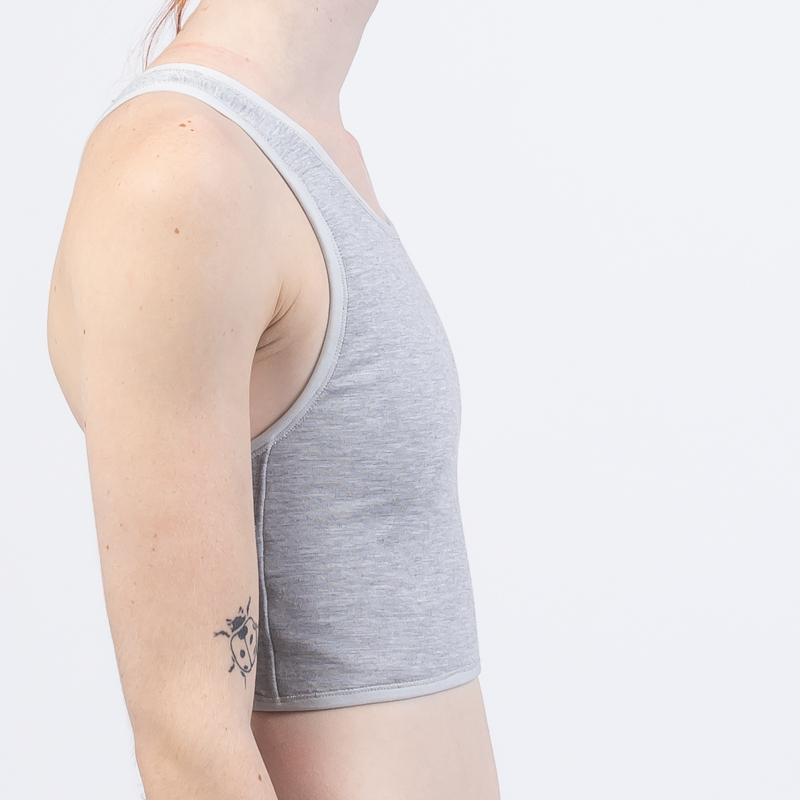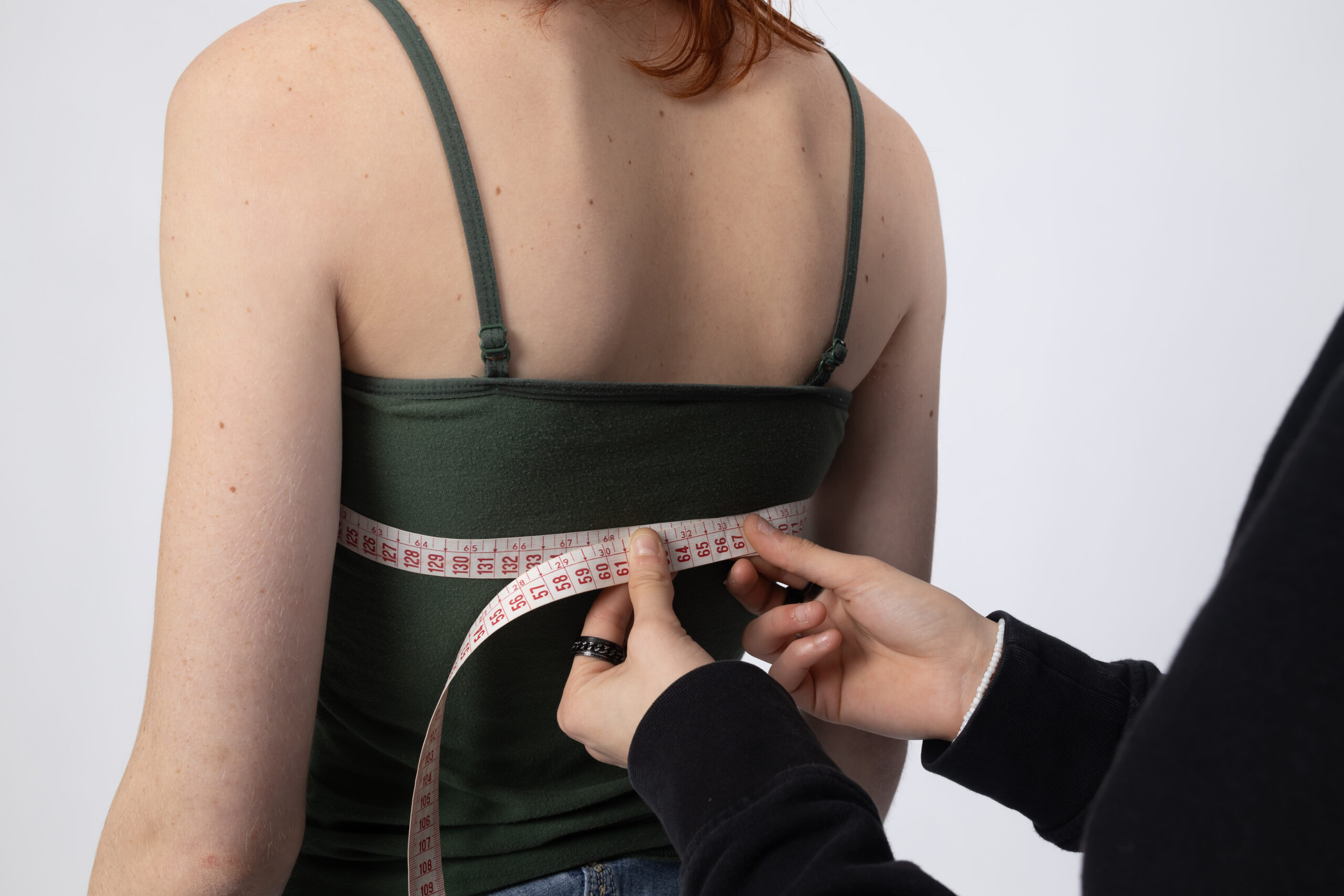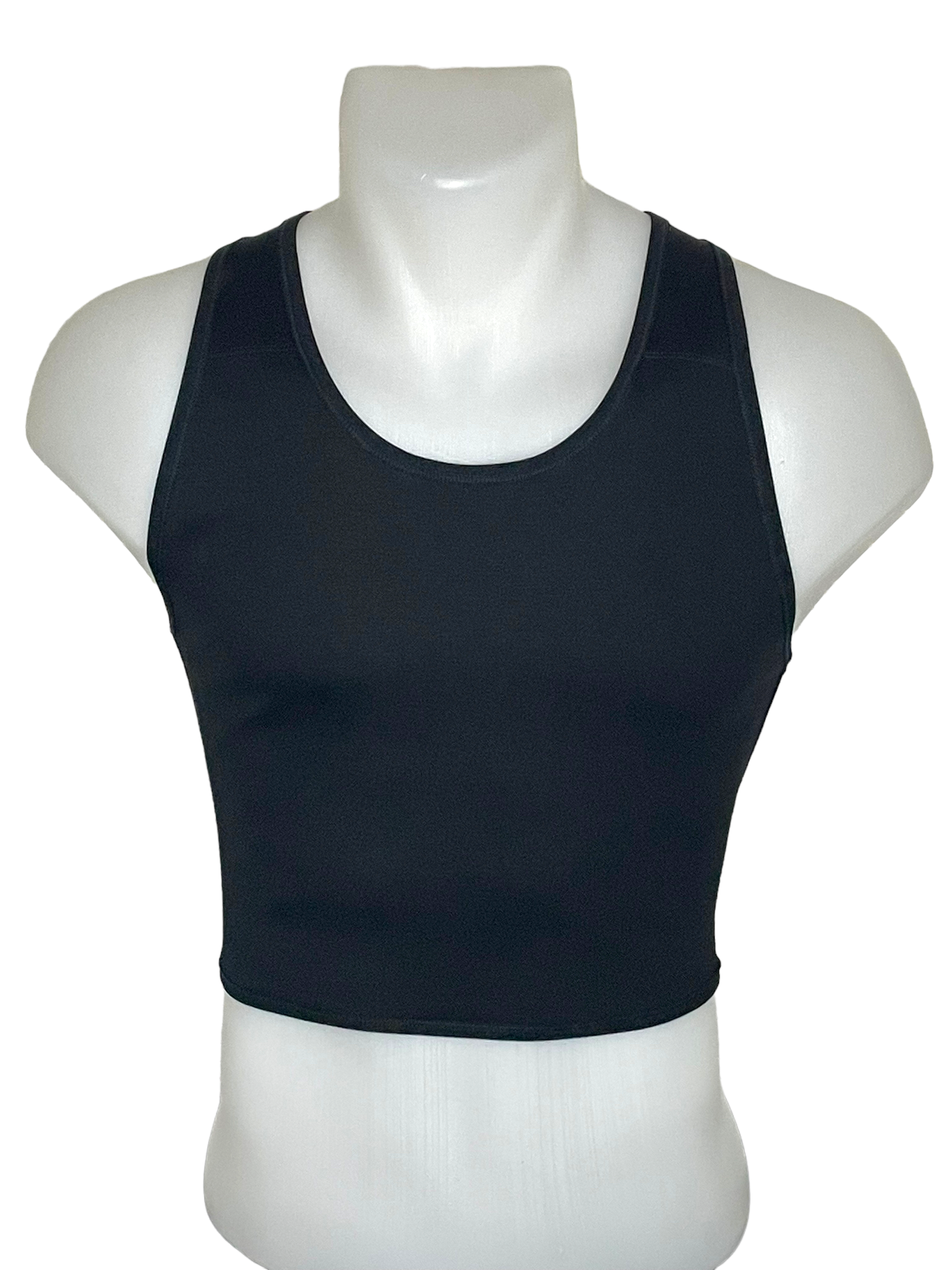Information on
Binders
Do you want to know everything about binding and how to bind safely? You can read it here.
What is a binder?
A binder is a garment designed to flatten the chest, creating a flat chest appearance. It is important for your body to bind safely. Although they resemble sports bras, binders are specifically designed for this purpose. They are often worn by non-binary, genderqueer, or transgender individuals who wish to have a flatter chest. A binder is also commonly referred to as a chest binder, trans binder, FTM binder, or compression vest.
What does a binder do?
A binder is designed to flatten the chest, creating a flat chest appearance. Using elastic and supportive materials, a binder compresses the breasts without hindering breathing, making it a safe and effective tool for gender-affirming care.
What is the binder made of?
Our binders are made from a sturdy 4-way stretch jersey fabric, making them suitable for daily use. The front panel is made from a double layer of this cotton fabric. For reinforcement, there is a layer of tightly woven polyester that provides minimal stretch. The back panel is reinforced with a thin, flexible woven polyester with a bit of stretch. This creates significant pressure at the front, effectively flattening the chest and providing a smooth appearance.
You wear a soft cotton fabric against your skin with minimal polyester! The edges of the binder are trimmed with stretch tape, ensuring a nearly perfect fit.
- Binder material: 80% cotton, 15% polyester, 5% elastane
- Front panel reinforcement material: 95% polyester, 5% elastane
- Back panel reinforcement material: 92% polyester, 8% elastane
- Washing instructions: Wash at 40°C, suitable for the dryer
What is safe binding?
There are various methods to flatten the chest, but not all are healthy and safe. For example, using duct tape is strongly discouraged as it is not elastic and can cause rib bruises or even fractures. It can also cause permanent skin tears (striae). Other issues include headaches, back pain, fatigue, and breathing difficulties. Research indicates that binding too tightly and too often can cause immediate or long-term issues such as numbness, skin changes, and scarring. A total of 27 potential complaints have been identified. Transundeez binders are specially designed to flatten the chest as much as possible while providing enough elasticity to allow for proper breathing and preventing skin tears. The trans son of the founder of Transundeez helped develop the perfect model and has worn these binders for years without complaints. If you do experience issues, it is important to discuss this with your doctor or gender team.
We have written several blogs about binding that may be interesting to read:
What to consider when buying a binder?
When choosing a binder, it is essential to pay attention to the right size, material, and type to ensure both comfort and safety. It is wise to invest in a quality product and seek advice to make the best choice. For questions, you can always contact us via the contact form or by phone. Additionally, pay attention to the following aspects:
- Size: Ensure you select the right size. A well-fitting binder provides sufficient compression without being too tight, allowing you to bind comfortably and safely.
- Material: Choose breathable and elastic fabrics suitable for long-term wear. Avoid non-elastic materials like duct tape. All binders from TransUndeez have a cotton interior, providing extra comfort.
- Type: Various styles are available, such as short and long binders. Choose a style that suits your needs and comfort. This can vary from person to person.
- Quality: Invest in a binder known for its quality and durability. We offer high-quality binders.
- Usage: Consider when and how often you will wear the binder. Some binders are better suited for daily use, while others are more suitable for sports or swimming.
- Support: Read reviews and ask for advice from others in the transgender community to make an informed choice.
How to determine the right binder size?
Choosing the right binder size is important to ensure comfortable and safe use. Here are the steps you can follow to choose the right binder size:
- Measure your chest circumference: Use a measuring tape to measure the circumference of your chest at the level of your nipples. Ensure the measuring tape is straight and tight but not so tight that it cuts into your skin.
- Select the binder you like, then click on a size, and the number of centimeters for the circumference will be displayed.
- Consider your body type: In addition to your chest circumference, your body type is also important. Some binders are designed for specific builds (e.g., slim, broad, tall), so read the product descriptions carefully to see if there are additional guidelines.
- Read reviews and experiences: Reading reviews from other users can help you understand how a specific binder fits and feels. This can help you make an informed choice.
- Still unsure about the size?
Try the binder out: Once you receive the binder, try it out calmly. Note how comfortable it feels, whether it flattens your chest sufficiently without causing discomfort or pain, and whether it stays in place during daily activities. At TransUndeez, you can exchange it if the size is not quite right.
Is a binder bad for you?
Wearing a binder is not necessarily bad for you, but it is important to do so safely and responsibly. If you wear a binder that is too tight or wear it for too long, it can lead to discomfort and health issues such as breathing problems, back pain, skin irritation, and even rib damage.
Here are some tips for wearing a binder safely:
- Choose the right size: Make sure your binder fits well and isn’t too tight.
- Limit wearing time: Do not wear a binder for more than 8 hours a day and avoid wearing it while sleeping.
- Take breaks: Give your body regular breaks from binding to reduce strain.
- Listen to your body: If you experience pain or discomfort, it’s important to remove the binder and allow your body to rest.
By following these guidelines, you can wear a binder in a way that is safe and minimizes risks. It’s also a good idea to consult a doctor if you have concerns about using a binder.
Can a binder cause harm?
Wearing a binder can pose certain health risks, especially if not done correctly. Here are some potential downsides and risks of wearing a binder:
- Breathing problems: A binder that is too tight can compress the chest, making it harder to take deep breaths. This can lead to shortness of breath, dizziness, and in some cases, fainting.
- Rib and chest pain: Prolonged or improper use of a binder can cause pain in the ribs and chest muscles. In severe cases, the ribs can even bruise or fracture due to constant pressure.
- Back and shoulder pain: The compression of a binder can cause tension in the back, shoulders, and neck, leading to pain and discomfort.
- Skin irritation and infections: Friction and sweating under a binder can cause skin irritation, such as rashes, chafing, or even infections, especially if the binder is not washed regularly.
- Restricted movement: A binder can limit your range of motion, which may be uncomfortable during physical activities like sports. This can also increase the risk of injury.
- Impact on circulation: Binders that are too tight can restrict blood flow, leading to numbness or tingling in the arms or other parts of the body.
- Effects on lungs and rib cage: Prolonged binder use can, in some cases, lead to changes in the structure of the rib cage and lung function, especially in young people whose bodies are still developing.
While binders play an important role in gender-affirming care, it’s crucial to use them safely and responsibly. This means choosing the right size, limiting wear time, listening to your body, and taking breaks to prevent potential harm.
Does a binder hurt?
A binder should fit snugly but should not cause pain when worn. A binder can cause pain, but this depends on various factors such as the fit, how long it’s worn, and how your body reacts. Here are some situations in which a binder can cause pain:
- Incorrect size: If the binder is too small or too tight, it can cause pain in the chest, ribs, back, and shoulders. A well-fitting binder should feel firm but not so tight that it becomes uncomfortable or painful.
- Prolonged wear: Wearing a binder for too long can lead to pain and discomfort. It is recommended not to wear a binder for more than 8 hours a day and to always remove it before sleeping.
- Improper technique: Incorrectly putting on or positioning a binder can create pressure points and friction, leading to painful spots on the skin.
- Physical activity: During intense activities, like sports, a binder can feel restrictive and cause pain or discomfort. In such cases, it’s important to wear a binder designed specifically for movement or to take breaks.
- Physical reaction: Some people may experience pain from the constant compression of the chest, even if the binder fits well and is worn correctly.
If you experience pain while wearing a binder, it’s important to take immediate action. This might mean removing the binder, taking a break, or trying a different size or style. It’s also wise to consult a doctor if you have persistent pain to avoid potential health issues.






